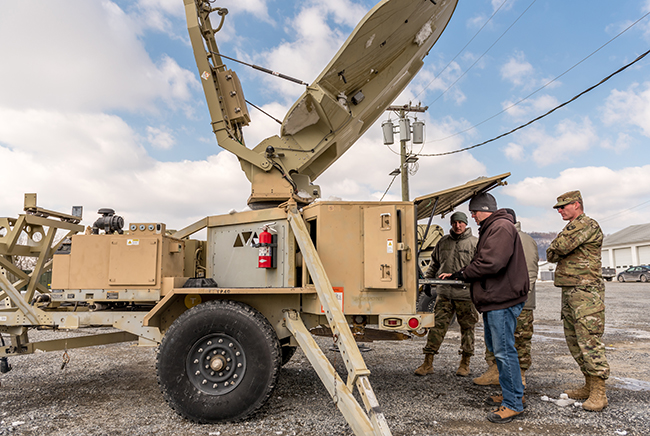
Technicians from Tobyhanna Army Depot work with the Pennsylvania National Guard to assess, troubleshoot, and repair 14 satellite transportable terminals required for upcoming deployments, in Annville, Pa., March 7, 2019. Army photo by Thomas Robbins.
A council formed within the Pentagon’s new Space Development Agency has started meeting with the goal of hearing what service members need from a new array of military assets in orbit.
The SDA Warfighter Council stood up as part of the agency’s establishment in March as a “conduit for ongoing, two-way communication between the SDA and the warfighter,” according to Defense Department spokeswoman Jennifer Elzea. It includes about 20 member organizations spanning the Joint Staff, combatant commands, service acquisition branches, and the intelligence community.
“The organizations represented on the council demonstrate a clear connection to the warfighter and the consideration for threats the warfighter may face,” Elzea said. “The Joint Staff, the geographic and functional combatant commands, the intelligence community, and the military services all feed that vital perspective.”
Members have met twice so far this year, including its first meeting on May 1. They plan to convene quarterly, and another meeting is slated for the end of 2019. The group isn’t planning any visits to bases or industry facilities at the moment, Elzea said, but did participate in an SDA tabletop exercise to weigh in on how the systems SDA pursues would support operations.
“The council informs the ‘threat-driven’ needs of the national defense space architecture at the core of SDA’s mission,” Elzea said. “It provides expertise and recommendations on current and emerging operational challenges, and the adversarial threat environment to inform the SDA’s architectural development, prototyping, and experimentation plans.”
She declined to discuss specific issues the council is mulling or what they have advised so far.
With the council’s input, the SDA can get a better idea of which pursuits will have the greatest return on investment for military operators around the globe. Research officials are still open to a wide range of options “as long as those solutions address the threat environment and can be woven into” the existing network of military space assets, Elzea said.
“We need to have global targeting of things, say, larger than a truck,” Derek Tournear, assistant director for space in the Office of the Under Secretary of Defense for Research and Engineering, recently told Government Matters. “We want to be able to target anything around the world, 24/7, anything about that size or larger. We want to have artificial intelligence-enabled global surveillance all around the world at any given time.”
SDA’s notional architecture, paired with new ground control systems, will spread small satellites across low Earth orbit to handle missile defense, space situational awareness out to the moon, communications, command and control, and more. The agency has had a rocky first six months with the departure of its initial director, Fred Kennedy, and skepticism on Capitol Hill and within the defense community about how its mission compares to other development groups in the Pentagon.
The agency held its first industry day over the summer and is working toward multiple technology demonstrations in fiscal 2021.
“The key backbone that we have is a mesh network of interconnected satellite links,” said Tournear, who is serving as SDA’s acting director. “We’re going to do a demo in fiscal year ‘21 to be able to show that we can have this mesh network, satellites talking amongst each other, just like the internet works on the ground, we’ll have that in space.”
The Pentagon is working toward issuing a solicitation to industry to help with that backbone. Another demonstration in 2021 will prove whether SDA technology can track missile threats, followed by fielding in 2022, Tournear said. Officials hope to roll out upgrades every two years after that.